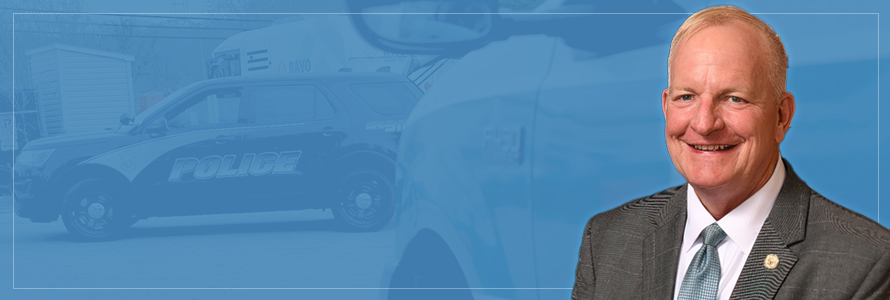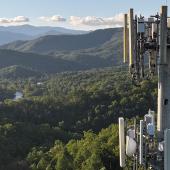When Walter “Pete” Landon was growing up in Montreal, Canada, he idolized the Royal Canadian Mounted Police. But he was an American citizen whose father had moved the family north for work, and therefore couldn’t fulfill his dream of becoming a Mountie. Now, after more than three decades spent in law enforcement with local and state departments in Maryland, he can look back on a career in law enforcement with pride and the insights of how policing has evolved in that time. In particular, he has seen how technology has improved the way officers communicate and share information, starting with the age-old phenomenon known as “skip.”
“When I started with the Greensboro Police Department in 1983, we had the old four-channel radio. Sometimes it worked, sometimes it didn’t. Sometimes I was heard, sometimes I wasn’t. And then when I became a Maryland State Trooper, I thought all the issues would be fixed. Well, little did I know that I would end up having to converse with Orange County, California, sometimes to get to the barrack because I could talk to them through skip better than I could my own barrack,” says Landon, who served for 30 years with the Maryland State Police and is now the director of the Maryland Governor’s Office of Homeland Security.
Skip is the name used to describe atmospheric conditions that allow for radio transmissions to travel long distances. These conditions can bounce signals from state to state or even from country to country. Skip is a big part of the CB radio culture, and thousands of people across the United States talk long distances when conditions allow them to do so.
“It was a matter of the way the wind was blowing that night, whether the department in California heard us or I heard them,” Landon explains. “A couple of times it was pretty serious. If I went into a bar fight and made arrests in a rural area, I was calling for backup or to let the barrack know what was going on. And several times I actually had to go through Orange County and have their dispatch call the Maryland State Police and let them know what was going on. And that was just the way it happened at that time.”
Leading Maryland public safety through tech transformations
As technology advanced over the years and Landon’s career spanned from patrol trooper, investigator, and academy instructor to special operations, aviation command, and lieutenant colonel, he’s experienced first-hand the changes in how law enforcement communicates, from the basic to the advanced.
When he oversaw the State Police’s special operations division and command, he needed to be able to talk to multiple agencies at any given time. For this to happen, he had to carry up to six different radios and two handhelds in his vehicle. Communications were cumbersome for Landon and his fellow officers.
“If you go back to the history of 9/11 and the World Trade Center, it was obvious that public safety did not have much interoperability. Then the big push was to flood the market with as much equipment as possible. Everybody jumped on board, got the equipment and nobody really thought about the back-end of that – the infrastructure needed to sustain that equipment and the communications networks. In Maryland, we went from several disparate networks and people not really talking to each other, to now we’re becoming organized, putting people in talk groups for Maryland FiRST [First Responder Radio System Team], and paying attention to make sure we’re appropriately using the bandwidth that's available, whether it’s cellular or from a radio communication standpoint.”
When Maryland started building its statewide 700 MHz public safety land mobile radio (LMR) system — Maryland FiRST — in 2012, it brought a new ability to communicate across the state. “I can talk to someone on the eastern shore of Maryland, down near Ocean City and speak to someone clear as day up in Cumberland. I now have one handheld that I can use to talk to anybody that I want. I think that demonstrates how things have progressed.”
Bringing public safety broadband to Maryland
Landon is also an advocate for the complementary role that the nationwide public safety broadband network, or FirstNet, has with Maryland’s statewide LMR system. “These two systems really do work well together. We are finally giving everybody what they need, whether it’s a cell phone or a radio, whether it’s the towers or the backup or the infrastructure to run it.”
LTE coverage has been a key factor for public safety agencies deciding whether to make the move to FirstNet. Landon, who lives in a rural area of the state and has FirstNet service on his work cellphone, understands the importance of building the network where it’s most needed.
“There were several places in Maryland, including my own house, that still had very little coverage. You didn't have the ability to communicate. And I think FirstNet and the approach of taking the scientific method of figuring out the best places to position equipment [for public safety] has paid off,” he says. “FirstNet through the coverage that it’s provided – it’s truly a network that works. I think we’ve seen the quality of not only the equipment, but the infrastructure that’s being created has made communication so much better. Maryland is kind of unique. We are small, but we go from the mountains to the beach, to the water in between, to the urban and the rural areas. It seems like the FirstNet approach complements the way that Maryland’s trying to do business from a communication standpoint.”
Staying connected is paramount in Landon’s dual roles as Governor Larry Hogan’s Homeland Security director and Deputy Chief of Staff, both of which keep him busy and on the road around Maryland. He has the oversight of “everything public safety-minded,” including the military, the state police, corrections, and emergency management.
“Probably everything that you could think of in a single day that goes on, either my portfolio members or I have a touch on it. That could be anything from a natural or manmade disaster or emergency to a terroristic event to a military incursion. And sometimes all those things are all bundled up in one incident. What occurred at our nation’s Capital on January 6 is a perfect example of how the public safety community came together and had to act quickly to preserve the public peace and protect people.”
Landon says he appreciates how the FirstNet Authority and AT&T are working with public safety and listening to their concerns and feedback.
“I would tell anyone, if you listen to what FirstNet has to offer, where they’re going and the way they're going about it, one would be foolish not to consider how it could improve their operation,” he says. “There’s nothing worse than being out on a figurative island realizing you can’t really communicate. Because the truth is that police officers, emergency managers, first responders, and EMS, it could be seconds and their lives could change and the lives of the people they are sworn to protect just by the virtue that they don’t have the right communications platform. And I think that's what FirstNet serves to overcome.”




















